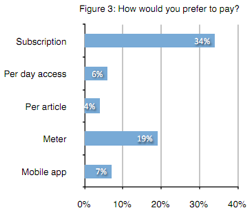 Twelve percent of Canadians are willing to pay for ringtones, but only 4 percent are willing to pay for news.
Twelve percent of Canadians are willing to pay for ringtones, but only 4 percent are willing to pay for news.
A survey of almost 1,700 adults by the nonprofit Canadian Media Research Consortium (summary, pdf) finds it’s hard to get people to pay for any kind of digital content, but that news ranked behind movies, ebooks, music, games, and, yes, ringtones in willingness to pay. If their favorite news sites started charging, 92 percent said they would simply find a free alternative — with no significant differences among age groups or education levels.
Southward-focused Canadians got a head start on the paywall experience this month when they were the first to come under The New York Times’ paid-content umbrella. Interestingly, the CMRC study found that — if there were absolutely no free news sources available, something unlikely in the land of the CBC — the type of news Canadians would be most willing to pony up for is breaking news — which the Times has said will often be made available without restrictions to Times readers, even those past their monthly article quota. (What does “breaking news” mean? The survey doesn’t say. I suspect the respondents would have provided about 1,700 definitions.) “Hard,” international, and investigative news were also more likely to be judged payment-worthy, with entertainment news a tougher sell.
Men were more likely than women to pay, and French speakers more likely than English speakers, the survey found. As for how they’d prefer to pay (if they had to), 34 percent of the willing adults would prefer a flat-rate subscription model, with the Times’ metered approach (free until you hit 20 articles a month) in second place. Very few respondents said they would pay per article or per day.
Of course, this is a survey about how people feel, not what they do. The New York Times has not released digital subscription data since putting up the wall. The other Times, The Times of London, on Tuesday released data indicating at least some people are paying, citing 29,000 new digital subscriptions in the last five months — even as higher-priced paper subscriptions continue falling.
“If only consumers were as comfortable paying for content as owners would like them to be, the future would be a lot rosier,” the report concludes. “Paywalls might work for selective publications, such as The Wall Street Journal and the Times of London but given current public attitudes, most publishers had better start looking elsewhere for revenue solutions.”